Lady Morgan's Vengeance, The Blancheville Monster, The Third Eye, The Witch (1963, 1966)
Directed by: Alberto Di Martino, Damiano Damiani, Massimo Pupillo, Mino Guerrini
Written by: Bruno Corbucci, Carlos Fuentas, Damiano Damiani, Giovanni Grimaldi, Mino Guerrini, Phil Young, Piero Regnoli, Ugo Liberatore
Starring: Barbara Nelli, Erika Blanc, Franco Nero, Gerard Tichy, Gioia Pascal, Ombretta Colli, Richard Johnson
GOTHIC FANTASTICO: FOUR ITALIAN TALES OF TERROR
AVAILABLE ON BLU-RAY: 17TH OCTOBER, from ARROW VIDEO
Horror fans the world over know of the Gothic classics that came from America’s Universal studios and Britain’s Hammer. However, Italy also produced many films in the form. I’m familiar with some of them including great works from Mario Bava, but Arrow Video have decided to release four rarer examples which I haven’t seen. So put on your nightgown, pick up your candelabra and follow me down the dark corridor….
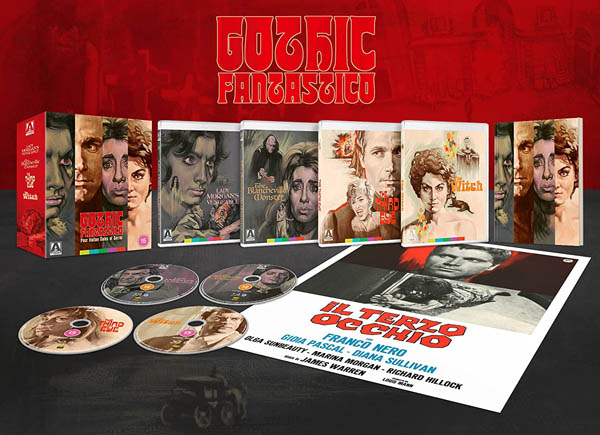
DISC ONE
THE VENGEANCE OF LADY MORGAN [1963]
AKA LA VENDETTA DI LADY MORGAN
RUNNING TIME: 86 mins
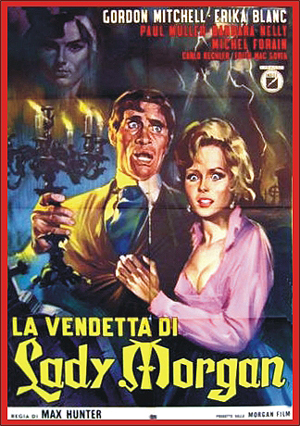
In Scotland, Susan, the young heiress of the Blackhouse castle, refuses to marry her uncle Neville’s friend Harold Morgan because she’s madly in love with a French artist named Pierre Brissac. But then Pierre is mysteriously pushed overboard during a sea voyage, so the heartbroken Susan agrees to the marriage and moves into the Morgan castle, only to find that the old governess has been replaced by a sinister new one named Lillian, while a friendly maid has been replaced too. It seems that Harold is after the Blackhouse family fortune, and together with Lillian, his main servant Roger and Terry the maid, are attempting to drive Susan to insanity….
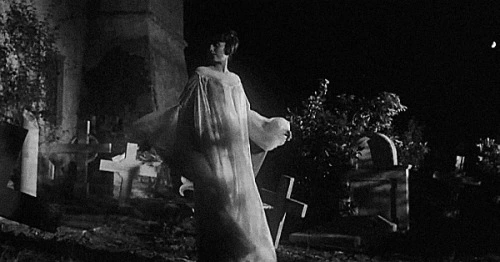
Given that the vengeance only takes up some of the final third of its running time after which there’s still some more stuff to happen, you could say that this film’s title is a little misleading, but that’s probably rather unfair, because Lady Morgan’s Vengeance is a cracking slice of Gothicness, full of traditional ingredients yet often tweaking them though the result comes across as rather fresh. In particular there’s the idea of bad people trying to drive the heroine mad. We’ve all seen this done many times before, in fact by 1965 Hammer had recently done it a few times with those Jimmy Sangster-scripted twisters which may have been a particular influence, but usually we’re much more in the dark, we don’t really know what’s going on and, even if we are starting to work it out, it’s very hard to work out why. Here, the main premise is set out quite early; our four nasties are definitely out to drive poor Lady Morgan crazy because they want her inheritance, and it’s even clear or quite easy to work out how they’re doing is. Therefore we have the prioritising of suspense over mystery, though not forever, as things eventually get rather crazy in terms of plotting and we just have to go along with it as screenwriter Giovanni Grimaldi, who sometimes leans on his earlier script for Castle Of Blood, decides to throw in whatever he can. The result might be a little lopsided but is tremendous fun and doesn’t forget to supply oodles of the required atmosphere, with not one but several sequences of the heroine in her white nightdress wandering about at night. Director Massimo Pupillo only made two other horror films, both the same year just before this one, before giving up on the genre, but judging by his work here that’s a great loss.
We open with our romantic couple spending an idyllic time in the countryside, leaning against a tree. We aren’t told where we’re supposed to be until right near the end, which might be just as well; there’s no way that this archetypal Italian setting in any way looks like Scotland. Anyway, Pierre can’t justify staying at the Morgan household any longer because there aren’t any more jobs for him to do and he has commitments back in Paris. Susan goes and tells her father Neville and the man who wants to marry her Harold that she doesn’t love Harold. Harold seems to take this rather well, replying, “Perhaps you need time to sit out your feelings””? Somebody tries to dispose of Pierre when he’s at sea, though he’s not killed and later wakes up in a hospital with amnesia which seems total except for the remembering of “So much water”. We jump awkwardly ahead to Susan about to marry Harold, which ends ingeniously so it seems like a nightmare of Pierre’s in one of several neat scene transitions. Susan goes off on a trip and returns to find the Morgan household rather different to how she remembered it, with a new maid and governess; apparently the former fell sick and the latter left. Governess Lillian is first seen descending the stairs in a typical introduction; she then puts Susan to sleep but she wakes up hearing Lillian’s voice telling her that her mind is going, “You are under my control” and “You will obey me”. Indeed it does seem to her that she might be losing her marbles, what with her thinking that she’s been locked in her room even though the key is actually in a fold in her dress, that she wasn’t poured any wine at dinner even though this is denied, and a snake crawling over her turns out to be string. This kind of stuff is almost always tense, but is here given a different dimension because we know what Harold, Lillian, Roger and Terry the Maid are trying to do, and can even sometimes work out how – I mean – for example – a tape recording being played in a secret place is an easy thing to pull off!
A doctor is called round, but to Harold’s barely disguised disappointment he says that Susan isn’t quite insane yet, while we also learn that Harold and Lillian are having an affair, though one wonders if Susan would be particularly bothered by this particular detail. She wants to see Neville and now comes one of the film’s great set pieces, as she wakes up to the sounds of a man screaming and goes outside, through a graveyard and into what might seem at first seem like a morgue but which is actually a dungeon where she finds Roger sadistically whipping her poor uncle who’s protesting about what they’re doing to his niece, before fainting – the latter meaning that the evidence of what she saw can be hidden when she revisits the place. Why is he being kept there? Is it only because of his objections? It’s no real spoiler to say that the nasties eventually achieve their aim, in another lengthy sequence which is almost ritualistic, and then the tale gets progressively odder. We know that there’s going to be some taking of revenge, and Grimaldi tries to have it both ways; we and the villains are witness to some poltergeist-like activity [which includes the ultimate heresy, turning whisky into water] in scenes which don’t have any charge of terror though are probably not supposed to, yet Susan is also turning them against themselves, exploiting cracks in the relationships between the four. Perhaps we didn’t need the supernatural activity at all, but then again the final third is pretty strange with much of what we see taking place in flashback with a ghost narrating, ghost/human sex, and, in what seems like a last act tagged on because the film was too short, vampires, meaning that some characters actually have to be killed off twice. There’s action which is reasonably well staged except for a daft bit where somebody seems trapped but then suddenly isn’t.
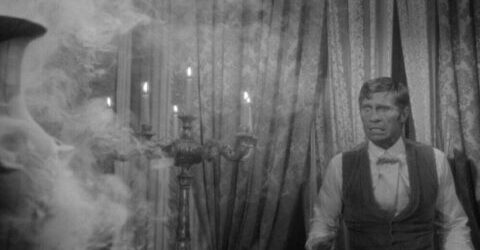
For much of the time, the general approach is in contrast with the more lurid style which was much becoming the norm in Italian genre cinema, with what seems like an attempt to partly replicate the feel of a film from the 1930’s. Once she takes up residence in Morgan Manor, there’s a lot of footage of Susan in her room, the camera of cinematographer Oberdan Troiani liking to slowly circle round it, taking in all the details in closeup and thereby producing a sense of claustrophobia in the place, of Susan being hemmed in, while elsewhere the large size of the rooms is often emphasised, the camera preferring to stay back. Perhaps the most evocative shot is a closeup of Susan looking out through the window while it rains heavily, the camera viewing this from outside so the water begins to obscure our view. Yes, it’s a familiar and metaphorically very obvious image, but one that lingers in the mind. Some grisly stuff does eventually take place, with even a scene where all the vampires each drink the blood of the same victim on the wrist, though this is handled relatively discreetly, even though it still has quite a strong effect and actually I’m not sure whether the filmmakers would have got away with such a scene being any more graphic. On the other hand though we do climax with a graphic horse trampling which not just features some excellent makeup effects but fine editing by Marianno Arditi so it really seems as if the horse is doing this. And In one of the two love scenes the guy’s lust seems extremely animalistic, with the woman clearly loving this; I won’t mention the participants because it would constitute the revelation of another twist, but you’ll know it when you come to it.
Said twist doesn’t entirely seem necessary, though it comes late in the day and the film is now clearly a rather different animal from what it was before. This will either delight, baffle or annoy viewers as any kind of sense is thrown out of the window, though that can be good. Barbara Nelli projects the right vulnerability as Susan, even when she’s dead, a nice change from the norm of performers making ghosts seem very sinister even if on the side of good. The sinister female side is ably covered by Erika Blanc, in the first of a great many roles in the genre; she’s very intimidating even when she’s hardly emoting, yet is also able to bring some humanity to the part. Of course when Gordon Mitchell, probably the best actor out of the many, mostly American, bodybuilders who went to Italy and became a success in peplum [sword and sandal] films, is in a movie, one tends to be drawn to his presence which is hugely muscular in more than one way; here he goes suitably over the top which is mostly in contrast to those around him. Then there’s the very fine music score by Peiro Umiliani which contrasts melodic lilting guitar and romantic strings with often unnerving orchestra and mellotron astringent passages which enhances the required atmosphere. The very low budget can’t help but show occasionally, such as with some very flimsy looking gravestones, but Lady Morgan’s Vengeance is very ably achieved from beginning to end, the handling being done with conviction even as the script gets progressively dafter – yet the idea of revenge actually making things worse is neat and the bleak finale quite brave even if it’s a little rushed. Unnerving and at times rather surprising, it’s a film that deserves to stop languishing in obscurity. Bravo to Arrow for opening the set with it
Rating: 









DISC ONE SPECIAL FEATURES
Original lossless mono Italian soundtrack
Brand new audio commentary by author and critic Alexandra Heller-Nicholas
Heller-Nicholas isn’t one for scene by scene commentary, and she has her work cut out here for a film about which there’s probably very little production information, so it’s great that this track, despite a lot of gaps, is as good as it is. She’s clearly very fond of the film, which certainly helps. While not afraid to use illuminating quotes from others, she adroitly calls the Gothic a combination of “melodrama, excess and transgression”. Much of the history of both the literary and the cinematic form may be known to listeners, but you’ll still hear some interesting stuff, such as her theory that Lady Morgan’s Vengeance is an unconscious answer to all those old Gothic tales which presented a stereotypical version of Italy.
Vengeance From Beyond: Brand new video introductions to each film by Italian film devotee Mark Thompson Ashworth [4 mins]
Mark Thompson Ashworth tells of how this film has no American involvement which probably explains the lack of an English dub, notices its fast pace and says that Pupillo didn’t want to be labelled as a horror director so left the genre after making this.
The Grudge: Brand new video essay on the film by author and producer Kat Ellinger [21 mins]
Despite the title, Ellinger doesn’t focus much on the film itself; instead she widens her gaze to discuss the Gothic horror boom which in Italy, interestingly, tended to centre more around women than in other countries. She also links these stories to the kwaidan and yurei films of Japan and South Korea, which usually had wronged female ghosts – and I have now even more films that I need to see!
When We Were Vampires: Brand new video interview with actress Erika Blanc [24 mins]
Blanc’s wry personality and attitude can perhaps be summed up by her saying that she used many aliases but doesn’t care less, or maybe by her saying that she’d like to learn how to use a computer so she can properly communicate with fans before saying what’s the point as she’s soon to be 78! She remembers how she got so nervous doing her first screen kiss with Mitchell that she could only do it properly after a glass of whisky that she was given on set, and even mentions some stuff from her private life!
Newly edited video interview with actor Paul Muller from 2014 [20 mins]
Unlike Blanc, Muller doesn’t even remember working on this film, though to be fair he did make far more of them. He does recall his early years, says how he thinks that actors who talk in interviews about how they prepare for ages for a part, and recalls meeting Bettie Davis who gave him a signed book about her life.
Newly edited audio interview with director Massimo Pupillo [20 mins]
This 1983 interview has Pupillo discuss his filmography, which is apparently more substantial than most film guides say because he used aliases. He says how he’s most proud of the documentary-like Sa Jana but, despite not being a fan of westerns and horror films, that he enjoyed coming up with solutions, such as using a tiny pump from a toy to make a heart look like it’s beating. He also recollects that Barbara Steele in Terror Creatures From The Grave was really arrogant about the project on set for three days before he told her off in front of everyone. Oh, and he claims something that I found hard to swallow; he was due to work on a sequel to Sergio Leone’s Once Upon A Time In America. Huh?
The complete original cineromanzo, published in Suspense in April 1971
Trailer
DISC TWO THE BLANCHEVILLE MONSTER [1963]#
AKA EDGAR ALLAN POE’S HORROR
RUNNING TIME: 93 mins
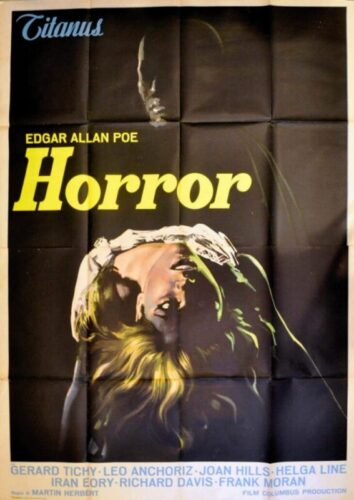
Scotland, 1884 or England, 1884 depending on what version you watch. Emilie De Bancheville returns home to the De Blancheville family castle a few days before her twenty-first birthday. Accompanying her are her childhood friend Alice Taylor, who recalls being in love with Emilie’s brother Roderic, and her brother John. Upon arrival, Emelie finds that her father died in a fire, and that Roderic has replaced all the servants and brought in the sinister Dr LaRouche who seems to be scheming something with housekeeper Miss Eleanor. Alice is awoken by sounds at night and, in the castle’s darkest tower, sees Eleanor injecting something into a disfigured man who turns out to be her father, still alive. Seeing as a family curse prophesies that Alice will bring the downfall of the De Blancheville line upon her twenty-first birthday, Eleonore may be poisoning Alice, or maybe Dr LaRouche is hypnotising her….
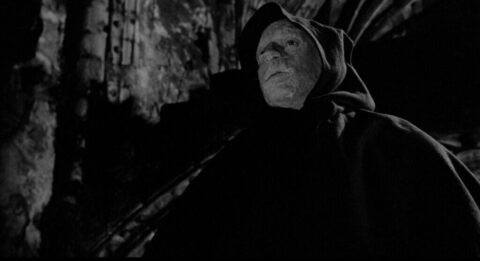
Imagine you’re a horror film heroine. Woken up by cries coming from the tower in the castle where you’re staying for the night, you go to investigate, being very brave and not thinking to bring somebody with you. You find a creepy woman putting a needle into a very deformed man, a sight which causes you to faint. The head of the household finds you and puts you back to bed. However, when you wake up again, you get up and head straight back the way you came! You’re really very very stupid, but because you’re a horror film heroine you still, just about, get away with it. This second Gothic doesn’t have a bonkers final act like Lady Morgan’s Vengeance but is perhaps packed even more with Gothic cliches. It’s obviously very much inspired by the Edgar Allan Poe-inspired films being made by Roger Corman at the time, at times doing a good job of replicating their style despite the black and white format meaning that we don’t get their stunning use of colour, though moving a lot faster. It’s very much an elaboration of The Fall Of The House Of Usher, though Poe themes are rife and Poe fans may notice elements of two other, far lesser known, stories; if you’re one, see if you can spot them. Screenwriters Bruno Corbucci and Giovanni Grimaldi also use some devices, if slightly tweaked, that appeared in the latter’s Lady Morgan’s Vengeance screenplay, while this time the creepy housekeeper really does look and act like Rebecca‘s Mrs. Danvers, resulting in a real hodgepodge yet one which still often really works, with just as many atmospheric sequences as the previous film, yet one which seems quite conscious of being on the edge of parody.
One may have to resort to chuckling at the knowing opening scene. We track across part of a forest – and unlike in the Corman/Poe’s it’s a real forest – to reveal a castle in the distance, and despite clearly being a miniature, it looks a darn sight more impressive than the one in the film above. The music on the soundtrack gets more and more agitated as the camera pans out from the family crest on the main door and goes up the side of a tower where we can see a figure moving the other side of a barred window; two hands now grasp the bars. And then up, at least in this version, comes the word HORROR, the original title – though would 1963 audiences have found this funny like me? Inside the carriage hurtling through the wood are Emelie and her friends, siblings Alice and John. They’re welcomed not by Joseph, the nice butler that Emelie expected, but by a more distant guy named Alistair who says he doesn’t know where Joseph went to. Dorothy the housekeeper was apparently too old so has also been replaced, a loud musical note accompanying a whip pan to her replacement – of course – standing at the top of the stairs. Alice is perturbed by some screams, but is told, “It was just the scream of a dog, our peasants have many of them”. Not nice old Dr Rochelle but a sinister Dr LaRouche shows up whereupon Roderic [get it?] ushers his new residents up to bed early. LaRouche and Eleonore seem to be up to no good, and Alice sees Eleanore injecting a deformed man with something. But when she returns there with Roderic nobody’s there! Roderic eventually decides to admit that his father survived the accidental burning down of the abbey he was in at the time and is now a monster; what’s worse now is that, due to Alice’s interruption, he’s escaped into the forest which means that he will no doubt get back into the castle. Eleanore and LaRouche were just trying to calm him down with a sedative.
The cloaked and hooded Count enters Emelie’s room while she sleeps, the silhouette approaching the bed being the film’s creepiest image. He seems to put her under some kind of hypnotic trance as he tells her to obey him – and yes, it really does seem like we’re watching a variation on Lady Morgan’s Castle for a short while, though there are two ladies on the side of good this time, with Alice being the one who does the investigating side of things while Emelie has no memory of her nighttime walks and seems to be in a trance. In what comes as such little surprise to us one wonders why we weren’t told us this at the beginning, Emelie and John are revealed to be romantically engaged, but then there’s also Alice and LaRouche which we’re a bit worried about, especially when LaRouche goes on about hypnotism which makes Roderic, who also likes Alice, suspicious of him. Mind you, Roderic spends much of his time playing some of the soundtrack music on the harpsichord, actor Gérard Tichy clearly playing some of the notes as well. Do we trust him? Who do we trust? Roderic is suspicious of Eleanore. Is it really father who’s lurking about and either trying to lure Emelie to her death or to drive her insane or both, or is it someone wearing a mask? I’m going to say that, sadly, I guessed successfully the answer to this. Things also seem to stall after the halfway mark, until we takes a startling digression when someone is buried alive. We probably expected this, seeing as Madeline Usher had that happen to her, but what startles is the way this is handled, with shots of a lengthy funeral procession inter-cut with shots of the victim and even her point of view and her voice-over conveying her terrified thoughts. The main inspiration of course is Vampyr, though the effect of the scene is partly undone by its rather ridiculous follow-on.
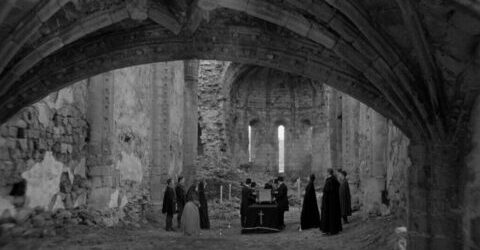
While most of the characters fancy each other, the slightly transgressive sexual element common to many Italian Gothics is virtually missing and the violence is extremely muted; there’s just one strangulation and an un-explicit killing by a large wooden cross. The plot could have used considerably more attention. Was the script from Natividad Zaro dashed off in just a couple of days? This family curse supposes that Emelie, on her twenty-first birthday, will cause the destruction of the De Blancheville family, yet the script seems to think that we won’t find it odd that Emelie is going to live with them. The curse is purportedly carved on the headstone of the family tomb? Surely this is something that she would have known about for many years, and it’s hardly the sort of thing that you forget. Far more problematic is that – okay – the Count – or whoever it is – is trying to end the family line, so why doesn’t he just, for example, stab her while she’s sleeping? – For goodness sake he stands by her bed while she’s asleep, if he’d brought a weapon with him his aim could be quickly achieved. But no, he decides that she will die in a much more elaborate way which also has far less chance of success. And why does he wait two days before the deadly date to do it? Surely he’d have attempted it much earlier in her life if he was so bothered about it? It just doesn’t hang together, and an absurdly miraculous appearance by one character with no explanation just seems like a late addition to a script because the producer or the director decided that he wanted a happier conclusion.
Director De Martino was one of those journeyman directors who was reasonably adept at all the genres he dabbled in but who tended to work on films that were rip-offs or cash-ins of American pictures and who had little real style of his own. Here, he must have been satisfied with his performers either staring with little emotion or emoting extremely dramatically, often with their breath seen coming out of their mouths indicating, as with the dead forest, that shooting took place in the middle of winter. A tableau where our two heroines are in the foreground with our two servants and doctor standing menacingly behind them is quite effective. While Helga Liné’s sinister Eleanor is probably the character who we’re most drawn to on screen, nobody really stands out, yet the performers do work well as an ensemble. The film’s highlight is probably when Emelie is being drawn to the crypt and is followed by the Count which make much use of just one shot, the miniature castle on the near right and an excellently matted in abbey on the far left, both dwarfing the two tiny human figures as they almost ritualistically enact their dance of death. A dream scene where various characters appear to Susan as the fog machine works overtime is another obvious Corman influence, though unlike those films this one makes prominent use of outdoor settings, most notably the ruined abbey which is a terrific locale and used to great advantage by cinematographer Alejandro Ulloa. It seems to be the same one which was later used in Tombs Of The Blind Dead. This time the score by Carlo Franci is very much in the Les Baxter mood, playing constantly, enhancing every dramatic beat. A harpsichord baroque passage sticks out every now and again, as well as a slow string track, full of despair, for the ailing Emelie, though a love theme is the only properly melodic piece. Not really a classic but crammed full of things to enjoy, The Blancheville Monster seems to be situated right on the edge of parody, but were the filmmakers aware?
Rating: 









DISC TWO SPECIAL FEATURES
Original lossless mono Italian soundtrack
Original lossless mono English soundtrack
As is often the case I watched most of the film with the English dub; you’re rarely hearing the original voices on the Italian dub either and many of the performers speak their own language. It’s a reasonable dub.
Brand new audio commentary by filmmaker and film historian Paul Anthony Nelson
I hadn’t heard Nelson before but hope to hear him again soon, because he provides a most excellent track here, full of enthusiasm and giving us the expected context and biographies but commenting on specific scenes too, thereby giving us the best of both worlds. He reckons that the Gothic genre was running out of steam by the time this film, which must have seemed old-hat, came out, says that Martino didn’t think of the film but did like the fact that his father made its mask, and gives out some fascinating information about a period where people were often buried alive, with various devices being put in coffins so somebody who’s alive would survive or be freed, while the Duke of Wellington lay in his coffin for two months just to make sure he was dead! A very impressive track.
Castle of Horrors: Brand new video introduction by Italian film devotee Mark Thompson Ashworth [6 mins]
I don’t know why these introductions weren’t placed on the same screen as the films so one could play them just before moving on to the films. Anyway, we learn something that I didn’t notice while occasionally flicking over to the Italian language version: the latter calls the Blanchvilles the Blackfords and is set in England unlike the English dubbed version which takes place in Scotland. Ashworth also informs us that Martino claimed he was mostly inspired by Alfred Hitchcock, and that at one point Tichy was told by Martino that he looked too serious as he was filming a scene, and that he should look happier because he was getting into a great car!
Are You Sure that it Wasn’t Just Your Imagination: Brand new video essay on the film by writer and pop culture historian Keith Allison [21 mins]
Allison goes over the early history of the Gothic form and emphasises how important Curse Of Frankenstein was [and he’s right, it totally changed the face of horror], while saying that tales in the style of Poe, with their emphasis on psychology and their ambiguity, suited the European mindset. He says that The Blancheville Monster “fails to make an emotional connection”, though is still obviously very fond of it.
Welcome to the Manor: Brand new video interview with author and filmmaker Antonio Tentori [10 mins]
Tentori can’t help but go over some of the same ground that has been already explored, but hearing it from an Italian perspective is nice. He points out the influence of Riccardo Freda and mentions that Martino was considered to be the most American-style of directors in Italy, something that he didn’t like at all.
Opening credits for the US release of the film [3 mins]
Trailer
DISC THREE
THE THIRD EYE [1966]
AKA IL TERZO OCCHIO
RUNNING TIME: 90 mins
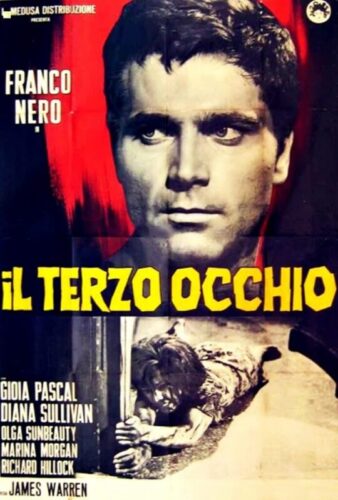
Mino, a wealthy count and taxidermist, decides to marry his fiancée Laura, a decision that infuriates not only his domineering mother but their plotting maid Marta, who has desires of marrying the count someday herself. Mother fires Marta, so Marta shoves her down a flight of stairs and strangles her while Laura has gone out for a drive. However, Marta has also sabotaged the brakes of Laura’s car so it plunges off a cliff. Mino, who was following her in his own car, is just too late to save her. This causes the already “on the edge” Mino to crack. Sometime later, he goes out and brings back another woman, but she’s horrified when she notices who is in the bed beside her and he has to resort to strangling her….
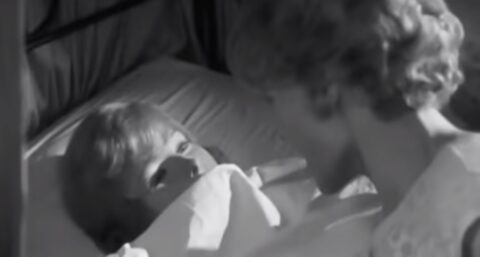
If the above synopsis seems rather familiar to you, don’t worry, you’re not going mad; Joe D’Amato’s much better known 1979 Beyond The Darkness was a remake of this flick [which never even saw a video release], so much so that some scenes are virtually the same, which makes it very wrong that, on the credits of the later film, only the name Mino Guerrini, who only actually directed this version, comes up and is solely credited with “story”, ignoring the contributions of – well, not Gilles De Reys the medieval serial killer who must be been credited as a joke – but certainly Piero Regnoli and Phil Young. The Third Eye, whose rather odd title, at least it terms of relating to what it’s about, is explained in this line of dialogue, “It’s as if I have a third eye, one that sees only violence and death”, isn’t as sick and grisly as the D’ Amato flick, a film which was made when censorship had relaxed to an extent that filmmakers in 1966 would have only dreamed of, but it was certainly strong meat for the time, and it’s probably a better movie really, certainly better acted and photographed, while the final act opens up the story in a way that Beyond The Darkness, for whatever reason, opted not to do. Shot partly in that familiar Italian horror movie location the Villa Parisa, it’s really rather different to the first two films in this set, more reality-based and less Gothic in feel. The main inspiration actually seems to be Psycho, with some of its ideas and motifs cropping up, though we never saw Norman Bates cut then pull open a bird he intends to stuff, before pulling its insides out. This really must have made some 1966 viewers feel sick, but then this film made it clear early on that it was going to be one that would push the boundaries of what was generally considered acceptable.
Idyllic shots of a young woman walking with flowers in the countryside inter-cut with those of a man pacing up and down outside the front of his house open the movie. The woman is Laura and the man her fiancee Mino, who’s certainly in love with her but isn’t happy that he had to wait an hour for her to pick some flowers for his mother, the key thing here being that they were for his mother, but then nobody seems happy about anything in this household. Mother thinks that Laura is “common”, Marta the maid doesn’t like Laura either though that’s more because she wants Mino for himself, and Mother considers Marta “lazy” even though she’s grown up in the house with her and her son. It’s a wonder that they haven’t already killed each other. When Mino and Laura have a chat in Mino’s bedroom, dear mother is watching through a peephole. Are we to surmise that she’s watched her son having sex this way? Knowing this film, we probably are. There’s certainly something very off about the relationship between Mino and his controlling mother, even though we aren’t given any explicit details; she’s no doubt made him the way that he is, though Mino seems to want to resist her. Laura decides to leave for a while because her sister is returning from college, while mother and Marta have a row. Marta initially seems a bit pathetic, hanging on to mother’s leg as she walks away, but then she suddenly changes and, in a fit of rage, pushes her down the stairs into the cellar, then kicks her bloodied face and chokes her with repeated pummels to the neck in a rather extended murder sequence. Laura is also soon gotten out of the way with her car crash, which then makes Mino totally lose it.
There’s no sense of it happening sometime later, but it most certainly can’t be the next day when Mino goes out on the pull. At a jazz club he watches a stripper perform; she notices him and mouths something to him. We cut to her in his house, but she’s finding the place rather unsettling, as well she might. We’re still not at the stage where we can see proper nudity, so the camera cheekily pans towards the curtain behind which the woman is taking her bra and panties off, asking us to imagine what we’d see. The two go to the bed to have sex but he can’t seem to get an erection. Then she notices a horrid sight beside her and is killed for her screaming, the strangulation presumably bringing Mino to some sort of orgasm. While we only see Laura’s body in the same shot as Mino or any of his women twice, something that again we can put down to censorship, the implications of necrophilia are still pretty astonishing. Marta sees it all and offers up a new arrangement. If Mino will marry her, she won’t go to the cops when he gets that urge to murder and will help him dispose of the bodies. She even suggests they use hydrochloric acid so that no traces are found, though Mino seems more bothered about telling mother everything, presumably thinking that she’s still alive, even if we never see her stuffed corpse anywhere. It’s implied that Mino then kills more girls, though we only see one, a prostitute. And then a year after the murders first began, a surprise visitor shows up; Laura’s younger, red-headed, nearly identical looking sister Daniela. Mino thinks Daniela is the second coming of Laura, and the plot now hinges on something happening ludicrously quickly. It’s not long after this that Beyond The Darkness ended, but not this film, which transfers to a road and then a beach.
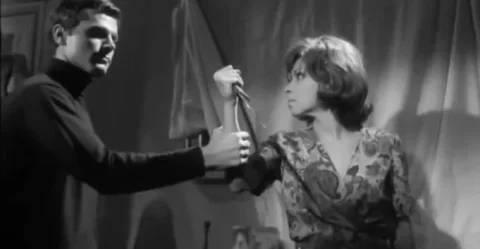
The frantic pacing is quite dizzying considering all the scheming and the madness that’s taking place; we could have done with a bit more explaining of one or two characters. Marta isn’t easy to get a handle on at all. I suppose we’re just intended to pick up on the fact that she’s always been madly in love with Mino; blackmailing him is clearly just another end to achieve this, but why isn’t there a scene where she confesses her adoration to him? I suppose he’s always known so it was thought that such a scene wasn’t deemed necessary, but it would have given their relationship more clarity for the viewer. A much bigger question is why this lurid tale was filmed in black and white at a time when not very many films were; maybe this was done so the censors would be kinder? Still, cinematographer Alessandro D’Eva makes the very most of the format, creating a lot of moody atmosphere in a film which you wouldn’t think would have much room for it, as well as emphasing the decay of the main locale. There’s an emphasis on close-ups, especially of Franco Nero, sometimes from odd angles or strangely framed to enhance our sense of his character’s madness. The introduction to the jazz club has the camera get in close to the faces of patrons as it pans around the edge of the place; only after it’s done all this do we get a more panoramic view. The camera often prowls the house and we even get a split diopter shot, with Laura in the background and the face of mother looming in the foreground on the opposite side of the screen. Guerrina doesn’t let this kind of thing slow matters down, though a dream sequence, which I assume is intended to signify the moment when Mino really becomes insane, doesn’t quite work because Mino seems to remember shots from the film which he wasn’t present at.
While we never see a blade go into a body, the violence is drawn out and after you’ve watched the film you may feel as if you’ve seen something much more graphic movie than it actually is. Of course one shouldn’t expect a sensitive look at madness here, especially as this is a film where Mino certainly isn’t the only mad one, though it does feel as if our screenwriters didn’t really work out their main character and just threw in what they wanted. In one moment he’s stroking one of his stuffed birds in a rather suggestive way, though by now we shouldn’t be particularly surprised. Nero, clean cut and looking his young age in direct contrast to his breakout role as Django earlier the same year, doesn’t give a particularly complex performance, but it’s an effective one in terms of the film that it’s in, and close-ups of his intense eyes are a good device. Erika Blanc, previously seen in this set in Lady Morgan’s Vengeance, isn’t really given much to work with and therefore doesn’t seem to try very hard. In fact the strongest performance might actually be of Gioia Pascal as Marta, which is quite remarkable seeing as, apart from a bit part not long before, she didn’t make any other films. Pascal expresses vividly her character’s obsessive, masochistic love while keeping things restrained. Maybe she doesn’t eventually succeed in filling out this underwritten role, but it’s a sterling effort nonetheless. Francesco De Masi is credited with composing the music score, but apart from two jazz numbers it seems to be recycled from The Ghost. The lush main theme, heard often in the early scenes, projects an ironic feeling of romanticism, while an odd electronic-sounding noise with percussion underscores some darker moments very well. The Third Eye generally succeeds with its blending of the Gothic with more up to date nastiness, and its sheer gall.
Rating: 









DISC THREE SPECIAL FEATURES
Original lossless mono Italian soundtrack
Original lossless mono English soundtrack
This is another reasonably solid English dub.
Brand new audio commentary by author and critic Rachael Nisbet
Nisbet is another commentator I’d never heard before. She sometimes sounds too much like she’s reading from her notes, but refuses to leave any gaps which is very admirable indeed. The Anglosising of many of the names apparently hides the fact that Alberto Di Martino and Ruggero Deodato worked on this film, and we’re told that Deodato recalled Guerrini, clearly something of an eccentric, getting naked and defecating on the set. Nisbet has unearthed a great deal of information, such as that a sex scene between Laura and Marta was originally planned. Nisbet is frequently scene specific and does often tell us what’s going on, but that helps make this such a good listen if you’re doing the ironing or something. There are also perceptive observations, such as Laura and Daniela being visually linked to water. A third track that’s very good. Will the fourth maintain the quality?
The Cold Kiss Of Death: Brand new video introduction by Italian film devotee Mark Thompson Ashworth [8 mins]
Ashworth bizarrely begins by saying that The Third Eye wasn’t dubbed into English, which quite clearly isn’t the case judging by this set! Interestingly though, he quotes the explanation for the film’s title in its Italian version which is a bit different to the English dub, “It’s as if I have a third eye, and it always stares in the same direction”. It’s a bit more subtle. We learn that in the original script there was a trap door leading to an acid bath, and mother was a medium. Ashworth himself filmed in the Villa Parisa and learned it was supposedly haunted, but a solo nocturnal stay revealed nothing!
Nostalgia Becomes Necrophilia: Brand new video essay on the film by author and filmmaker Lindsay Hallam [11 mins]
Hallam takes us chronologically through the film and makes her own adroit observations as she does, such as by stating that Mino is stuck in “arrested development“, and that, following in from American film noir, Italian Gothic cinema was a response to the emancipation of women, revealing fear of such a development, yet The Third Eye and others, in contradiction, also show the old ways as having become corrupt and decrepit.
All Eyes On Erika: Newly edited video interview with actress Erika Blanc [11 mins]
Blanc returns for another interview, and thank goodness, because she has such a great personality. Most interestingly, she remembers being contacted by the producing company to film a lesbian scene with Pascal, which clearly links with the original script containing such a scene which went un-filmed, largely due to the censors. Seeing as it was in the ’80s though, it was a pretty daft suggestion by then to finally shoot it. Blanc also recalls Nero always studying English and playing a prank on Guerrini, both mentioned in the commentary but nice to hear from her. Her reason for choosing her alias Diana Sullivan is lovely.
DISC FOUR
THE WITCH [1966]
RUNNING TIME: 109 mins
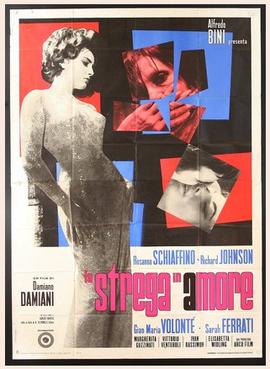
Sergio Logan is a heartless philanderer who’s being followed about by a mysterious old woman. Finding out that she was responsible for putting a “Help Wanted” ad for a librarian that seems to have been written just for him, he follows her to a crumbling villa where she reveals herself as Consuelo Lorente, but he won’t be convinced to take the job until he meets her daughter, Aura, and decides that it might have a few more perks than he at first imagined. But then along comes Fabrizio the previous librarian who seems to have a thing with Aura. And what are the motivations of her strange mother? Or indeed Aura?
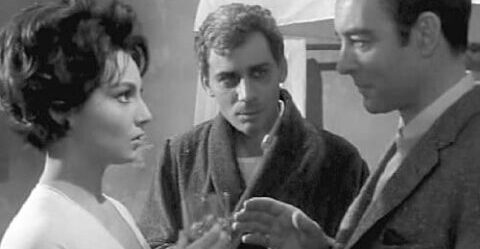
If The Third Eye was substantially different from Lady Morgan’s Vengeance and The Blancheville Monster, then The Witch, which bears little resemblance to any of the other films which have that title, is very different again. It’s neat of Arrow to begin with two very traditionally Gothic efforts and then present two films which are not just set in the present day but which have very different feels and approaches, even if both largely take place in decrepit villas, making considerable use of not just the visual and atmospheric natures of such a setting but also their metaphorical kind. While the English language version calls the film Strange Obsession which is a very generic moniker indeed, I do wonder if Damiano Damiani’s film would have worked better if given a different title, because the one it has immediately sets the viewer on the look out for something supernatural, indeed that the old lady who’s stalking our hero is probably a, well, you know, a witch. Then again it’s quite subtle in how it presents its fantastical aspects, relying on a few, often vague details, which does work in the film’s favour as long as you’re willing to be patient with what is a very slow burner indeed [easily the most leisurely paced movie of the set], but which makes us wonder if things would have still been good if said fantastical aspects hadn’t been in the film at all. Rather similar to Sunset Boulevard in places, much of it is a chamber piece where its four main characters all have agendas yet we’re not sure which any of them are, and one can even say that the story presents a feminist message, something which may seem strange considering the time this film was made in but it certainly seems to be there in my eyes. It’s significantly longer than the other three films in the set, but will probably leave a very strong impression.
This time we have jazz music playing over a black bar in the middle of a window view of Rome, which presents a very different mileau to what we’re used to in this set, though don’t worry, it’s not long before the gloomy villa becomes our main setting. The window belongs to the apartment of Marta, one of Sergio’s squeezes. “You mind making the bed?”, she asks, to which the reply is, “Who me?”. The next shot is of him lying on said bed, and she goes to make it herself after he gets back up. A real chauvinist, he doesn’t like it when she says that she wants to get married “in the future”, so we next cut to him asking another lady friend called Lorna if she can put him up for a while, telling her that he was chucked out when in fact he obviously just absconded because she wanted commitment. As I was watching these early scenes, it struck me that star Richard Johnson, who was once in the running to play James Bond, could have actually been a pretty good 007; he has the slightly rough suaveness of Sean Connery in spades in this movie until things begin to get weird for him. Sergio sees Consuelo the old lady who’s been stalking him and follows her to the villa, through a small door that opens from a much larger door [a nice semi-surreal symbolic moment] where she spills the beans – well, a few of them. The memoirs of her long deceased husband that she wants him to sort out do seem interesting, a passage that Consuelo reads out being suggesting a very “open” sex life. Complicating the issue further is that she already has a librarian called Fabrizio who supposedly thinks he runs the place, and maybe he should seeing as Consuelo not just seems to be being taken for a ride by creditors and is bankrupt from spending money on plastic surgery but almost collapses after drinking something. Sergio calls a doctor friend of his to come over, but is then distracted by the sight of Consuela’s daughter Aura, introduced playing the guitar, and immediately falls in love, though being him he tries it on with her almost immediately.
Aura seems to be playing games though, sending mixed signals, and what’s with the dead cat hidden in the greenhouse? Seeing Consuela’s dead husband lying in a glass casket is also a bit strange, and then Fabrizio turns up and Aura tells him that Sergio tried to rape her, though Fabrizio quickly sees through this lie. An understandably angry and confused Sergio is then sacked, but on his way out espies mother doing a weird dance and is then told by her that Sergio was the person responsible for killing the cat. Then, in the pawnbrokers across the road, Sergio is told that Consuela doesn’t even have a daughter. So is Aura imaginary to Sergio or real? Of course you or I would leave this household behind, but Sergio can’t keep away. “I’m in a living hell and I love it, you must give me absolution” says Fabrizio to him, Fabrizio also likes to watch Sergio and Aura when they are together, while Aura seems sexually aroused when Sergio pierces her in a fencing duel. As for Consuela, she wants Sergio to stay and replace Fabrizio, and thinks that he’s the right person to do this even though she doesn’t seem to want Sergio and her daughter to get together. A climactic revelation is perhaps too heavily signposted some time earlier, though as if often the case with these things it’s fun to watch our hero remain oblivious until it’s too late – and here it really is too late, the climax being quite startling yet consistent with a theme of man’s view of women which seems quite explicit, from the idea that Consuela surely can’t at all be attractive because of her age, to men often wanting what is mysterious and even dangerous over the normality of what they easily can have.
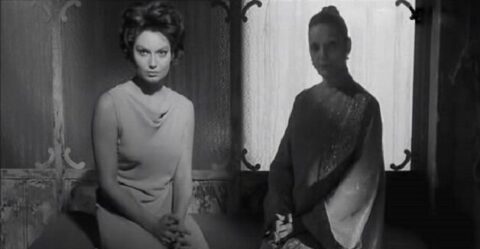
Indeeed one of the film’s most effective moments is when Lorna sees Sergio after he’s spent much time in the villa, but he barely notices her. He knows that he’s now trapped in more ways than one, but is compelled to remain. Aura, in the form of Rosanna Schiaffino, is a great tease, and this is nicely applied to the filmmaking as well, the camera of Leonido Barboni liking to get close to Schiaffino’s skin but then cutting away when she disrobes except for a quick flash of nudity in a mirror. Schiaffino isn’t a particularly strong actress judging by her performance here, but she does possess that kind of magnetism that makes us believe that she can draw men in in the way that she does; in fact the way in which she’s presented draws us in too. The main love scene is dictated by Aura’s insistence that she and Sergio don’t touch each other with their hands. It’s rather sexy as he uses his mouth to disrobe her. Despite my comments at the end of the previous paragraph it’s all still coming from a male perspective, but importantly it’s totally aware that it is and sometimes plays with this, even if not in a particularly sophisticated manner. While there’s a genuinely unsettling sequence of mother and daughter both doing a somewhat freaky dance, the most disturbing bit might be when Sergio tries to seduce Aura with talk about a thirteen-year old princess marrying a king. In terms of horror there’s hardly any in the conventional sense, and the witch here actually seems to hate cats, which is unusual; a scene of one being forcibly dragged into the house will upset some. A hell of a lot goes unexplained, which in a film like this works fine, even if there are certainly a couple of things that are still nagging at me as I type. And a fight scene in the library where the two participants knock a hell of a lot of stuff over seems out of place and almost comical in this otherwise serious affair – well, unless you tend to see the humorous side of tales like this!
The direction of Damiano Damiani, another genre stalwart who dabbled in most of the popular types of films in Italy but was most comfortable with political material, is very restrained considering the material. There’s a lot of clever positioning of characters within the frame, and much use of a fantastic llibrary set which as huge cobwebs, lots of pillars, and a maze-like nature, but Damiani and Barboni generally let the drama play out with little stylistic enhancement. A zoom near the end into Johnson’s eyes and some sudden employment of fast camera work have so much effect because it’s the first thing of its kind that we’ve seen in the movie. The impressive villa is fascinating without any visual enhancement, though we’d perhaps like to linger on certain areas a bit more. Johnson is pretty effective as his character, a type familiar at the time in Italian cinema but not Gothic cinema, who becomes more and more confused, and eventually has his treatment of women thrown back at him, though unsurprisingly its Gian Maria Volonte, usually chewing the scenery in westerns, who most commands the screen; his relatively small role as Fabrizio allows him to be typically and appropriately intense. Luis Bacalov’s score sometimes has its conventional dramatics, but tends to employ a light, poppy approach which maybe seems at odds with the material, though may have been intended to provide ironic commentary. The Witch will probably seem to be the slightest of the four films in this set to some, seeing as not much happens during long periods of its running time, yet it has a strong cumulative effect and in some ways comes across as the most modern of the film – which is both a positive and a negative thing I guess.
Rating: 









DISC FOUR: SPECIAL FEATURES
Original lossless mono Italian soundtrack
Original lossless mono English soundtrack
This is the weakest of the English dubs her, but certainly not terrible.
Brand new audio commentary by author and producer Kat Ellinger
Ellinger mucks in with one of her best commentaries, making it four fine tracks in this set. As usual she’s not scene specific, being closest to Heller-Nicholas out of the contributors here. Announcing this as “one of the most exciting restorations of 2022”, with the film “turning aspects of gender and sex on its head”, Ellinger typically delves a lot into context, is torn between thinking whether the film is a warning to men of dangerous female sexuality or an illustration of the strength of the latter. points out the large number of witches in Italian Gothic cinema in comparison with the likes of Hammer, and calls the film as presenting “not matriarchy but reverse patriarchy”. Her admiration of the film is obvious and Ellinger leaves no major gaps, despite this being the film in the set which has the least amount of production information available about it.
Witchery: Brand new video introduction by Italian film devotee Mark Thompson Ashworth [3 mins]
Ashworth oddly begins by saying that The Witch is for him “the least comfortable to talk about”, and indeed doesn’t spend much time on it, but does tell us a bit about the source novella Aura by Carlos Fuentas where the witch aspect was only hinted at.
Loving the Devil – Aging and Sexuality in La Streda D’Amore: Brand new video essay on the film by author and academic Miranda Corcoran [24 mins]
This very good featurette begins by discussing historical portrayals of witchcraft, beginning with the Babylonian Hummarabbi where the test for a witch was to throw them in a river; if she survived she wasn’t a witch [in opposite to a much crueler later test] before delving into the medieval Satanic witch which represented “the disorderly other”, in particular a figure of male fear of female sexuality [apparently it was written down that women were “more lustful and carnal than men“] and female aging, before going on to relate this to The Witch. Corcoran seems to less convinced than Ellinger and myself that the film undercuts its traditional sexist view of women.
The Rome Witch Project: Brand new video interview with author and filmmaker Antonio Tentori [18 mins]
Tentori goes over aspects of the film, most of which have already been covered, though he does tell us that Fuente wrote an interesting story about the real-life disappearance of Ambrose Pierce, that some shots resemble pictures in the comic books which Damiani was involved with at the time, and emphasises the film’s sensuality, including even its architecture.
PRODUCT SPECIAL FEATURES
Brand new 2K restorations from the original camera negatives of all four films
Generally these restorations are very good. The Blancheville Monster looks the best, with very nice balancing of the various monochrome textures and vivid blacks. A slight inconsistency in grain management is more prominent in the other three, though it never becomes problematic. The Witch looks the weakest, with a lot of rather soft shots which don’t seem to have been intended, but who knows? At the end of the day these films have probably never looked anywhere near as good.
High Definition Blu-ray™ (1080p) presentations of each film
Limited edition 80-page book featuring new writing on the films by Roberto Curti, Rob Talbot, Jerome Reuter, Rod Barnett and Kimberly Lindbergs
Fold-out double-sided poster
Limited edition packaging with reversible sleeves featuring original and newly commissioned artwork by Colin Murdoch
I had an absolute ball going through these films and their special features. Even if none of them are quite classics, they’re all absolutely fascinating and I’ll definitely be taking further looks at them. They’ve also been given great treatment by Arrow. Bravo! Highly Recommended for the true horror fan.





Be the first to comment